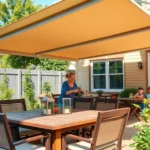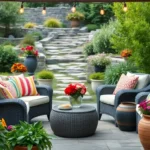We’ve all felt that instant sense of calm when stepping into a beautifully designed Japanese garden. There’s something magical about these tranquil spaces that transforms our backyards into peaceful retreats where stress melts away and mindfulness takes center stage.
Creating your own Japanese-inspired garden doesn’t require a massive budget or years of horticultural training. Whether you’re working with a sprawling industry or a cozy corner of your yard we’ll show you how to incorporate authentic elements like flowing water features, carefully placed stones and thoughtfully pruned plants that capture the essence of traditional Japanese design.
The best part? These timeless garden ideas work beautifully in any climate and can be adapted to fit spaces of all sizes. From minimalist zen gardens perfect for meditation to more elaborate designs featuring bridges and koi ponds we’re about to explore practical ways to bring this ancient art form into your modern outdoor space.
Zen Garden Design Ideas for Peaceful Meditation Spaces
Zen gardens offer the purest expression of Japanese garden philosophy through their deliberate simplicity and meditative qualities. These contemplative spaces invite quiet reflection while demonstrating how minimal elements can create maximum impact.
Raked Gravel Patterns and Stone Arrangements
Creating flowing patterns in white or gray gravel forms the foundation of authentic zen garden design. We recommend using decomposed granite or fine pea gravel as your base material since these options rake smoothly and maintain their patterns longer than coarser alternatives.
Straight parallel lines represent calm water and create immediate visual harmony in rectangular spaces. Start raking from one end of your garden area and work systematically toward the opposite side using a traditional wooden rake or garden rake with closely spaced tines.
Circular patterns around larger stones symbolize ripples and add ever-changing movement to static elements. Place three to five stones of varying sizes throughout your gravel area first, then rake concentric circles around each stone to mimic water flowing around obstacles.
Strategic stone placement serves as focal points and represents mountains or islands in zen philosophy. Choose weathered limestone, granite, or river rocks with interesting textures and natural coloring rather than perfectly smooth or artificially shaped stones.
Asymmetrical groupings of odd numbered stones create more visually appealing arrangements than symmetrical placements. Position your largest stone slightly off center, then add two smaller stones at different distances and angles to form a natural triangle composition.
Minimalist Plant Selection for Tranquil Ambiance
Limiting plant varieties to three or fewer species maintains the clean aesthetic essential to zen garden design. We suggest choosing plants based on their form, texture, and year round appearance rather than seasonal flowers or dramatic color changes.
Evergreen shrubs like boxwood, juniper, and Japanese holly provide consistent structure throughout all seasons. These hardy plants require minimal maintenance while offering the geometric shapes and deep green colors that complement gravel and stone elements perfectly.
Single specimen trees such as Japanese maple or pine create striking vertical elements without overwhelming small spaces. Plant your chosen tree in a prominent position where its natural form can be appreciated from your primary viewing area or meditation spot.
Ground covering mosses soften harsh edges between different garden elements while requiring virtually no maintenance. Encourage moss growth on stones and in shaded areas by misting regularly during dry periods and removing competing weeds promptly.
Ornamental grasses like mondo grass or liriope add subtle texture contrast against smooth gravel surfaces. Plant these low growing perennials in small clusters near stone arrangements to create gentle transitions between hard and soft garden elements.
Water Feature Japanese Garden Ideas to Create Serenity
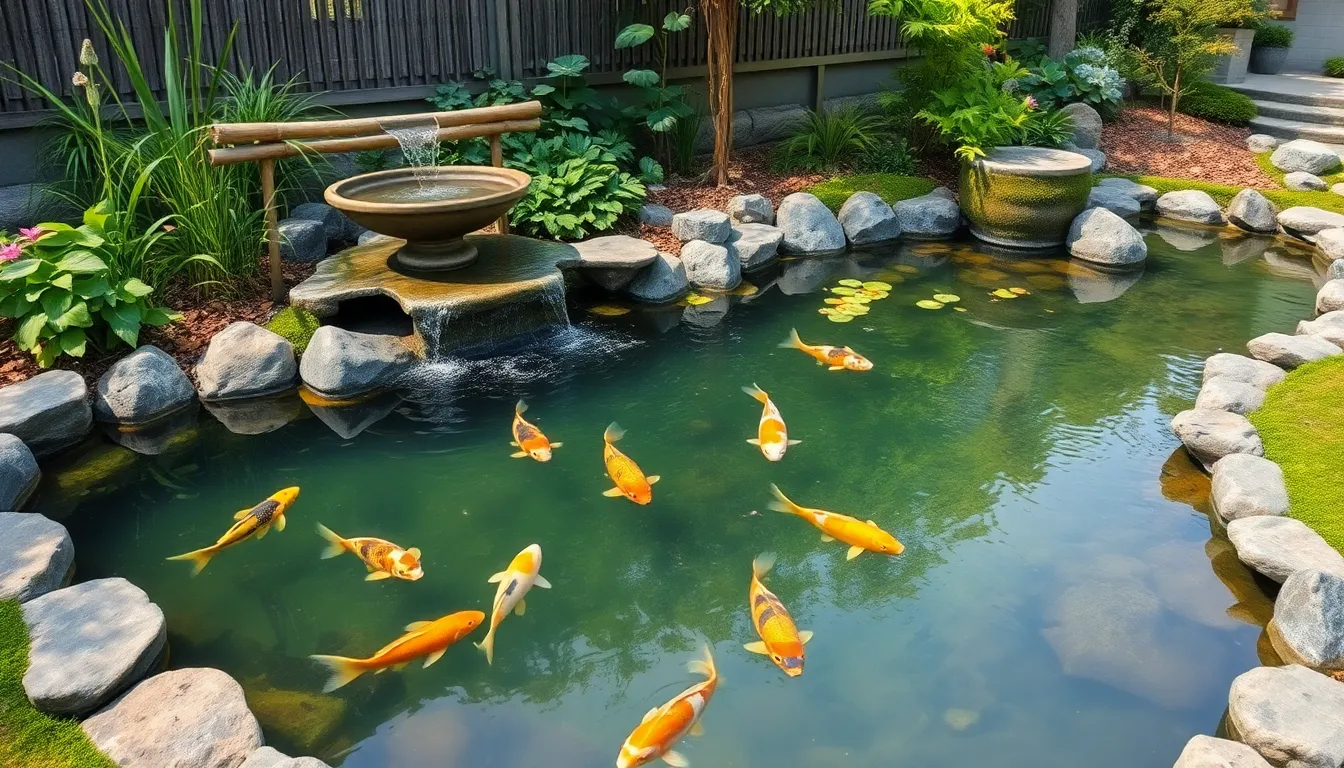
Water elements serve as the heart of Japanese garden design, bringing both visual beauty and peaceful sounds to our outdoor spaces. We’ll explore three essential water features that can transform any garden into a tranquil retreat.
Koi Pond Design Elements and Maintenance
Koi ponds create vibrant focal points that draw the eye while providing endless hours of peaceful observation. Natural stone edging gives these ponds an authentic appearance, while shallow slopes around the perimeter allow for strategic plant placement.
Clear water quality remains essential for showcasing the colorful koi fish swimming beneath the surface. Aquatic plants like water lilies and irises enhance the pond’s natural beauty while providing shade and oxygen for the fish.
Regular maintenance tasks include water quality testing, filtration system cleaning, and seasonal pond care to ensure healthy koi and balanced ecosystems. We recommend positioning larger stones strategically around the pond’s edge to create natural seating areas for meditation.
Bamboo Fountain and Stream Integration
Bamboo fountains, known as shishi-odoshi, use gravity to create rhythmic water movements that produce calming sounds throughout the garden. These traditional features work by filling with water until they tip forward, creating the distinctive bamboo fountain sound.
Gentle curved streams mimic natural waterways and can connect different areas of our Japanese gardens seamlessly. Rock and moss lining along stream edges creates an authentic appearance while preventing erosion.
Strategic placement near pathways or seating areas maximizes the meditative benefits of these water features. We find that positioning bamboo fountains where their sounds can be heard from multiple garden viewpoints enhances the overall sensory experience.
Stone Basin Water Features for Small Spaces
Stone basins called tsukubai offer compact water elements perfect for smaller gardens or entrance areas. These traditional basins were originally used for spiritual purification rituals and maintain deep symbolic meaning in Japanese garden design.
Natural stone construction ensures durability while bamboo spouts provide gentle water flow into the basin. Their simple design requires minimal space while still delivering the essential water element that Japanese gardens need.
Practical installation involves positioning tsukubai near garden entrances or along pathways where their symbolic purification meaning can be appreciated. We recommend choosing locally sourced natural stones to maintain authenticity while supporting sustainable garden practices.
Traditional Stone Lantern Placement and Lighting Concepts
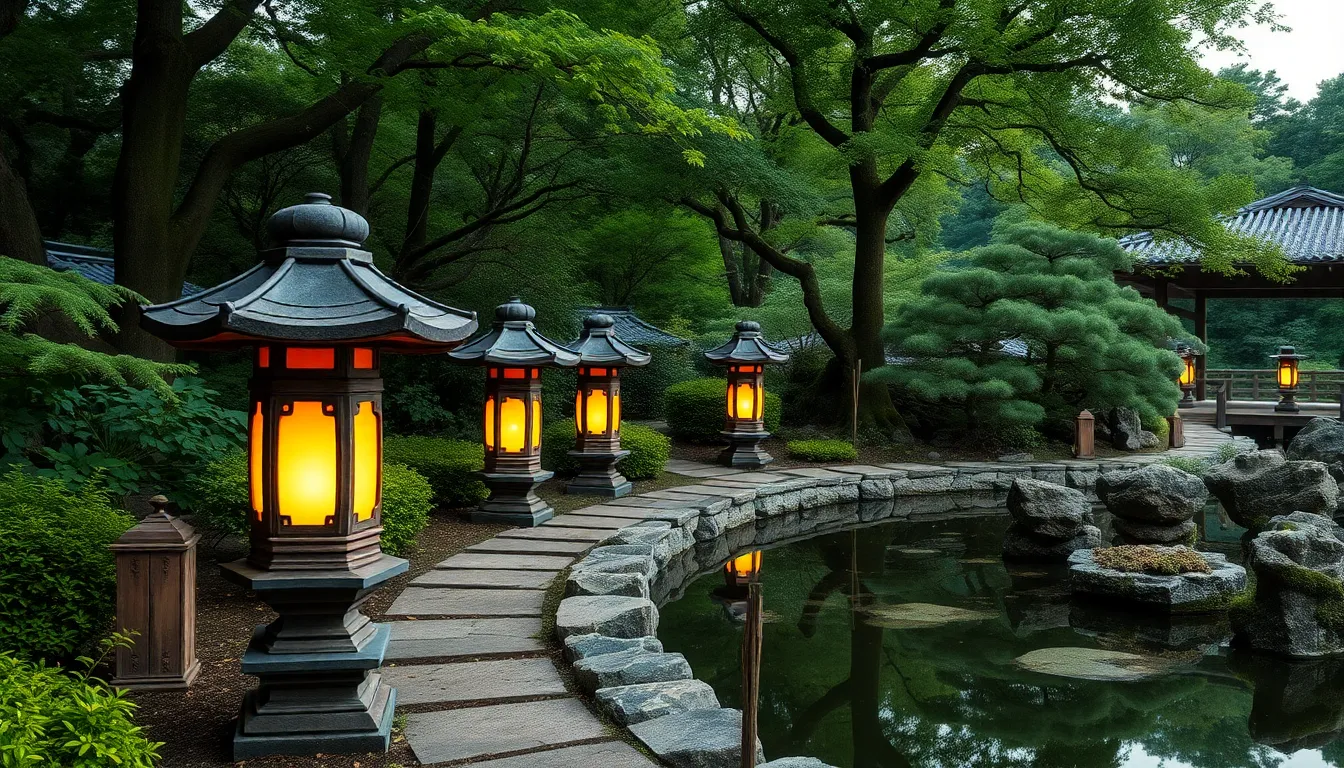
Stone lanterns serve as both functional lighting and symbolic elements that enhance the spiritual atmosphere of Japanese gardens. We strategically position these architectural features to guide visitors along pathways while creating visual focal points that reflect traditional design principles.
Granite and Concrete Lantern Styles
Pedestal lanterns dominate garden landscapes as large, multi-piece showpieces featuring elaborate base pedestals and ornate carved details. We recommend these substantial structures for spacious gardens where they can serve as primary focal points without overwhelming smaller plantings.
Buried lanterns (Ikegomi-gata) represent the oldest traditional design, partially embedded in the ground with characteristically wide, flared tops tapering to narrower bases. These understated pieces blend seamlessly into natural surroundings, making them perfect for creating subtle lighting accents near stone arrangements or moss gardens.
Snow-viewing lanterns feature distinctive legs and broad, rounded tops designed specifically for distant viewing across expansive garden spaces. We position these elevated structures where their graceful silhouettes can be appreciated from multiple vantage points, particularly near water features where their reflections double their visual impact.
Pagoda lanterns rise in tall, multi-tiered configurations that work exceptionally well in temple settings or large formal gardens requiring dramatic vertical elements. Set lanterns offer portable, compact designs ideal for intimate tea gardens or tabletop arrangements where flexibility and mobility matter most.
Solar-Powered Modern Alternatives
Solar-powered lantern designs mimic traditional stone aesthetics while providing energy-efficient illumination without complex wiring installations. These contemporary adaptations maintain authentic visual appeal through careful attention to proportions and surface textures that closely resemble carved granite or weathered concrete.
We’ve found that quality solar lanterns generate sufficient soft lighting for pathway guidance and ambient atmosphere creation. Battery technology improvements now allow these units to operate reliably through multiple cloudy days, making them practical choices for regions with variable weather patterns.
Modern solar variants offer installation flexibility that traditional lanterns can’t match, allowing us to experiment with placement before committing to permanent positions. This adaptability proves especially valuable when developing new garden sections or seasonal lighting arrangements.
Strategic Positioning for Evening Ambiance
Near water features, we place lanterns to create stunning reflections that add visual depth and movement to still pond surfaces or gently flowing streams. The interplay between direct lantern light and its watery reflection doubles the illumination impact while creating mesmerizing focal points.
Along garden paths, strategic lantern placement guides visitors safely through evening garden experiences while highlighting key transition points between different garden zones. We space these pathway markers at natural intervals, typically 8-12 feet apart, ensuring continuous gentle illumination without overwhelming brightness.
At garden entrances, welcoming lantern placement establishes the garden’s contemplative mood from the moment visitors arrive. These entrance markers signal the transition from everyday spaces into meditative garden environments, setting appropriate expectations for the experience ahead.
Near bridges or stepping stones, lanterns provide essential safety lighting while emphasizing these important structural elements as garden features worthy of attention. This positioning technique transforms utilitarian pathway elements into highlighted design components that contribute to overall garden composition.
Bamboo Garden Elements and Natural Screening Solutions

Bamboo transforms any Japanese garden into a private sanctuary with its natural vertical structure and symbolic meaning of resilience. We’ll explore how this versatile plant creates effective screening while maintaining the serene atmosphere essential to authentic Japanese design.
Living Bamboo Fence Installation Tips
Choose well drained soil with partial to full sunlight for optimal bamboo growth and health. Site preparation involves testing soil fertility, though bamboo adapts to various soil conditions with proper care.
Install root barriers made of thick plastic or concrete at least 24 to 30 inches deep around the entire planting area. This crucial step prevents bamboo’s aggressive spreading nature from overwhelming your garden space.
Plant bamboo in rows spaced 3 to 5 feet apart for effective privacy screening and natural fence formation. Clusters work well for accent areas while maintaining the organic flow of Japanese garden principles.
Water consistently to keep soil moist but never waterlogged, as bamboo thrives with regular moisture. Apply mulch around the base to retain water and reduce weed competition naturally.
Trim regularly and thin bamboo stalks to control size and promote healthy growth patterns. Harvest mature stalks for decorative purposes or to prevent overcrowding in your screening fence.
Decorative Bamboo Accent Features
Traditional bamboo fences called takegaki create visual boundaries while adding authentic texture to your garden design. These fences enhance the enclosure principle fundamental to Japanese aesthetics.
Shishi odoshi water spouts bring rhythmic sounds and gentle movement that enhance garden tranquility naturally. The bamboo fountain creates a focal point while symbolizing the flow of time and nature.
Bamboo walkways and ornamental bridges complement stone pathways with their minimalist design approach. These features connect different garden areas while maintaining the horizontal and vertical balance.
Small bamboo planters and decorative containers serve as sculptural elements within your garden layout. Lantern holders and bamboo ornaments provide subtle focal points without overwhelming the peaceful atmosphere.
Maintenance and Growth Control Strategies
Remove dead stalks annually to encourage healthy growth and maintain the clean appearance essential to Japanese garden design. Pruning weak bamboo promotes stronger development throughout your screening areas.
Use physical edging and root barriers to prevent invasive spread beyond designated garden boundaries. Regular monitoring ensures bamboo stays within planned areas while maintaining its natural beauty.
Maintain consistent moisture through regular watering schedules that avoid oversaturation of the soil. Bamboo requires steady hydration but proper drainage prevents root rot and other moisture related issues.
Monitor for pests such as aphids or mites using organic treatment methods that preserve garden harmony. Early detection and natural pest control maintain the ecological balance of your Japanese garden.
Protect young shoots during winter months and inspect for seasonal damage that might affect growth patterns. Bamboo generally remains evergreen but benefits from seasonal care and debris removal.
Rake fallen leaves and clear accumulated debris to maintain the minimalist appearance central to Japanese garden philosophy. Regular cleaning preserves the tranquil atmosphere and visual clarity your garden provides.
Japanese Garden Plant Ideas for Authentic Landscaping
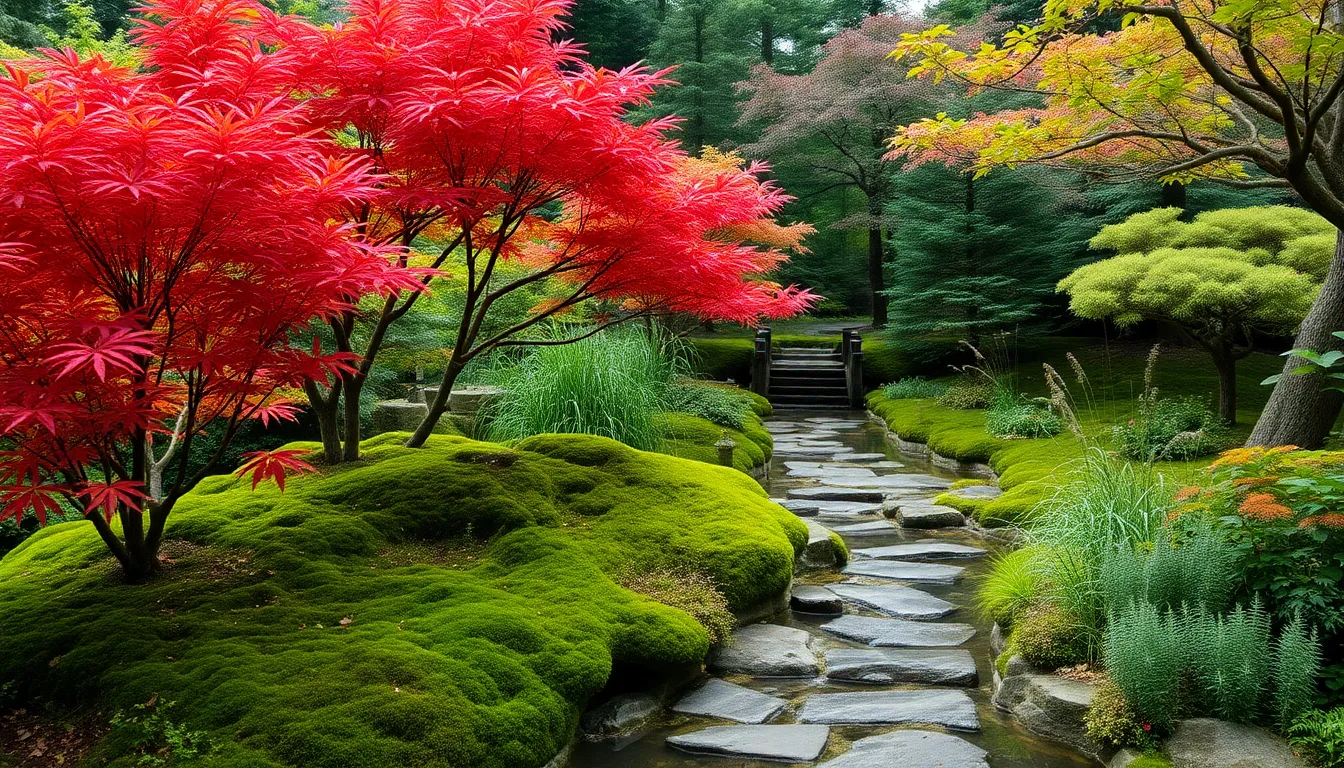
Building on the foundational elements we’ve covered, the right plant selection transforms your garden into an authentic Japanese industry. We’ll focus on key plants that embody the natural aesthetics, balance, and symbolism central to traditional Japanese garden design.
Maple Tree Varieties and Seasonal Color Changes
Japanese maples (Acer palmatum) serve as the cornerstone of authentic Japanese garden color dynamics, offering year-round visual interest through their delicate forms and dramatic seasonal transformations. Bloodgood varieties provide deep red foliage that intensifies throughout the growing season, while Sango-kaku (Coral Bark Maple) displays striking coral-colored bark that’s especially prominent in winter months.
Laceleaf maples with their dissected leaves create intricate shadow patterns and add textural complexity to garden compositions. These varieties transition from bright greens in spring and summer to fiery reds, oranges, and yellows in autumn, creating focal points that align perfectly with Japanese garden principles of asymmetry and natural symbolism.
Positioning strategies work best when we place these specimen trees where their seasonal color changes can be appreciated from multiple viewing angles. Their delicate branching patterns complement stone elements and water features, while their compact growth habits make them suitable for gardens of various sizes.
Moss Garden Creation and Care Techniques
Moss gardens represent one of the most tranquil and low-maintenance aspects of Japanese industry design, providing that signature emerald carpet that softens hardscape elements. Site selection requires shaded, moist areas with naturally acidic soil conditions, typically found under tree canopies or along north-facing garden sections.
Installation techniques begin with removing debris and lightly compacting the soil surface before spreading moss fragments or established moss mats. We recommend starting with small sections and allowing natural expansion rather than attempting to cover large areas immediately.
Maintenance protocols focus on preserving humidity through gentle watering during dry periods and avoiding foot traffic that can damage the delicate moss structure. Pruning surrounding plants maintains the necessary shade levels, while periodic removal of fallen leaves prevents moss suffocation.
Benefits extend beyond aesthetics, as moss provides natural soil stabilization and creates microhabitats for beneficial insects. This living carpet enhances the garden’s peaceful ambiance while requiring minimal inputs once established.
Ornamental Grass and Fern Combinations
Strategic combinations of ornamental grasses and ferns create layered textures that add movement and depth to Japanese garden compositions. Hakonechloa (Japanese forest grass) contributes graceful arching leaves and subtle golden color variations that complement surrounding stone and water elements.
Japanese Painted Fern varieties bring silvery fronds with purple stems, creating striking contrasts against darker backgrounds. Maidenhair Ferns offer delicate, fan-shaped fronds that flutter gently in breezes, adding ever-changing movement to otherwise static garden areas.
Planting combinations work most effectively when we group these plants in odd numbers and vary their heights to create natural-looking arrangements. These shade-loving plants thrive in the moist conditions found near water features and moss gardens, creating cohesive plant communities.
Seasonal interest continues throughout the year as ornamental grasses provide winter structure while ferns offer fresh growth in spring. Together, they reinforce the garden’s layered, natural feel while requiring minimal maintenance once established in appropriate growing conditions.
Pathway and Stepping Stone Design Inspirations
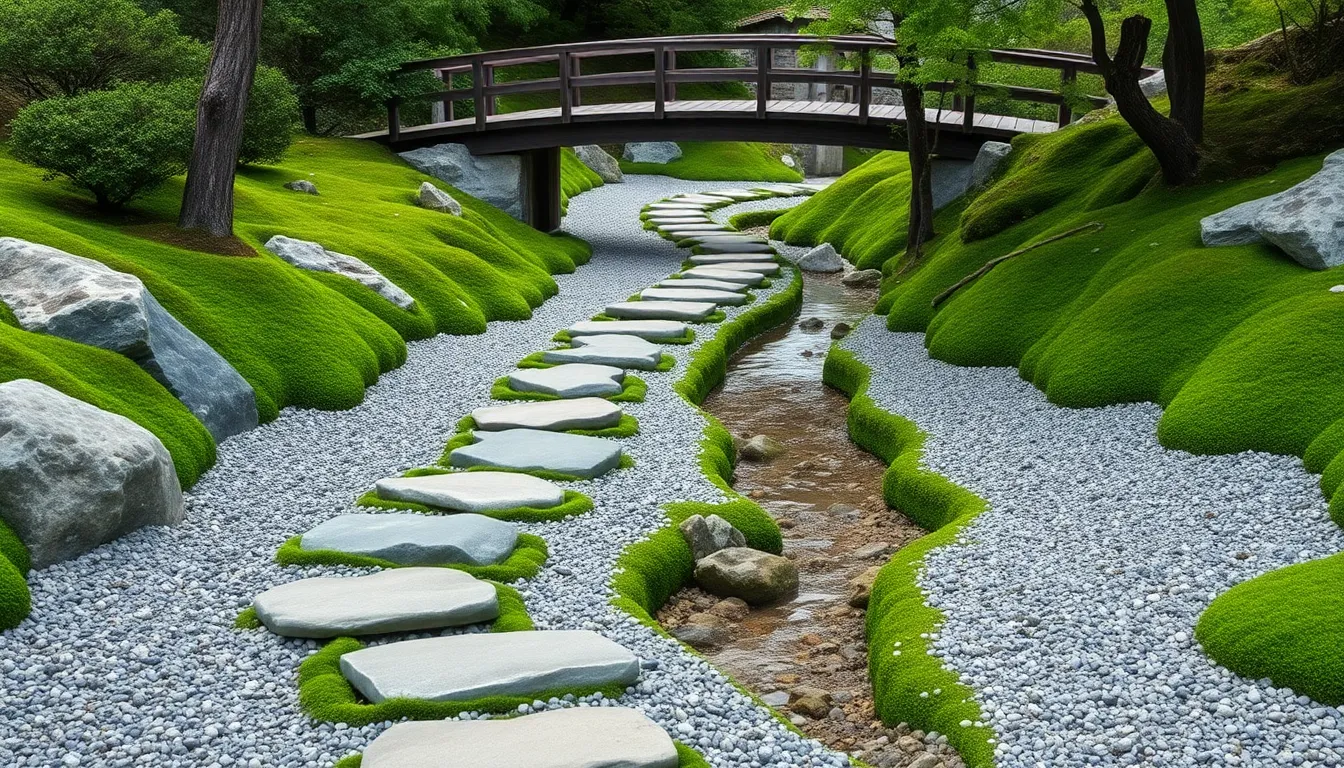
Japanese garden pathways serve as more than mere routes through your industry. They create purposeful journeys that encourage mindfulness while revealing garden views in carefully orchestrated stages.
Natural Stone Path Materials and Layouts
Natural stone remains the foundation of authentic Japanese pathway design, with flat topped stones arranged to appear effortlessly placed in moss or gravel settings. We recommend selecting stones that allow comfortable stepping distances while avoiding sharp angles that disrupt the garden’s harmonious flow.
Stone placement should mimic natural landscapes, where individual stones represent islands or peaceful resting points throughout your journey. Irregular arrangements create the most natural effect, encouraging visitors to slow their pace and contemplate each step. Consider your sightlines carefully when positioning stones at main crossing points, as these locations offer ideal opportunities to highlight stone groupings or feature small specimen trees.
Moss integration between stepping stones adds authentic texture while creating the illusion that stones float naturally within your garden space. This traditional approach connects your pathway seamlessly with surrounding garden elements while maintaining the minimalist aesthetic central to Japanese design principles.
Wooden Bridge Construction Ideas
Wooden bridges symbolize transition and connection in Japanese gardens, serving as both functional elements and meaningful focal points. Simple arched or flat bridge designs, crafted from untreated timber, work beautifully when crossing dry riverbeds or small pond features.
Yatsuhashi bridges offer traditional zigzagging designs that add visual interest while naturally slowing visitor movement through your garden. These slightly curving structures encourage contemplation and provide multiple viewing angles of surrounding water features or planted areas.
Construction should emphasize natural materials and simple joinery techniques that complement your garden’s overall aesthetic. Position bridges at strategic points where they’ll enhance your garden’s sense of journey while connecting different zones or elevating visitors above water elements for improved viewing perspectives.
Gravel and Sand Walkway Alternatives
Raked gravel and sand create compelling alternatives to traditional stone pathways, representing water through carefully crafted patterns that evoke waves and ripples. These materials establish immediate calm and visual order throughout your garden space.
Gravel applications work exceptionally well for dry riverbed designs, where proportionally more blank space than features maintains the essential balance characteristic of Japanese aesthetics. Contrasting materials at pathway intersections or directional changes help define your garden’s structure while guiding visitor movement.
Sand patterns require regular maintenance but offer unmatched meditative qualities as you rake new designs into the surface. Pebble arrangements provide textural variety while requiring less frequent attention than fine sand applications. Balance remains crucial across all gravel and sand applications, with thoughtful spacing ensuring your pathways enhance rather than overwhelm your garden’s peaceful atmosphere.
Small Space Japanese Garden Ideas for Urban Settings

Urban environments don’t have to limit our ability to create peaceful Japanese-inspired retreats. We can transform even the smallest spaces into tranquil sanctuaries by adapting traditional elements to fit modern living constraints.
Container Garden Arrangements
Container gardening offers us the perfect solution for creating flexible Japanese gardens in urban spaces. We can cultivate dwarf trees, moss, ferns, and Japanese maple varieties in appropriately sized pots, allowing easy repositioning based on seasonal changes or sunlight requirements. Drainage becomes effortless with container arrangements, and we’re able to relocate plants when apartment building regulations or changing light conditions demand it.
Bamboo containers work exceptionally well for housing ornamental grasses and small evergreen shrubs. Stone or ceramic vessels create authentic visual appeal while providing adequate root space for specimen plants. We can arrange multiple containers at varying heights to establish depth and visual interest, mimicking the layered appearance of traditional Japanese landscapes.
Plant selection focuses on compact varieties that thrive in contained environments. Dwarf conifers, small hostas, and creeping moss species adapt beautifully to pot cultivation while maintaining the essential Japanese aesthetic. We recommend grouping containers in odd numbers to create natural asymmetry, a fundamental principle in Japanese design.
Balcony and Patio Adaptations
Balconies and patios transform into intimate Japanese retreats when we carefully assess their unique environmental conditions. South-facing exposures receive abundant sunlight throughout the day, making them ideal for Japanese maples and flowering plants, while north-facing areas provide cooler, shadier conditions perfect for moss gardens and ferns.
Wind exposure becomes a critical factor at higher elevations, requiring us to select hardy plant varieties that withstand temperature fluctuations. We can install bamboo screens or trellises to create windbreaks while simultaneously establishing privacy from neighboring units. These barriers also serve as mounting points for climbing plants or hanging planters.
Water features adapt beautifully to small patio spaces through shallow stone bowls or compact fountains. We position these elements strategically to create focal points while ensuring the sound of flowing water masks urban noise. Stepping stones can guide movement across larger patios, while gravel sections define meditation areas within the limited footprint.
Vertical Garden Elements
Vertical gardening maximizes our available space by utilizing walls and screens for greenery placement without consuming precious floor area. Bamboo panels create striking vertical lines that add height perception and visual dynamism to cramped urban settings. We can mount climbing plants, hanging specimens, or modular planter systems on these structures for layered visual appeal.
Wall-mounted moss installations require minimal maintenance while providing the tranquil, natural texture essential to Japanese garden aesthetics. Small groundcover plants thrive in vertical planters, creating living walls that filter air and reduce urban stress. We recommend selecting plants with similar water and light requirements for each vertical section to simplify care routines.
Hanging elements such as wind chimes, small lanterns, or trailing plants add movement and sensory interest to vertical spaces. These features draw the eye upward, creating an illusion of expanded space while maintaining the peaceful atmosphere central to Japanese garden philosophy. Strategic placement ensures each vertical element contributes to the overall harmony rather than creating visual clutter.
DIY Japanese Garden Projects on a Budget
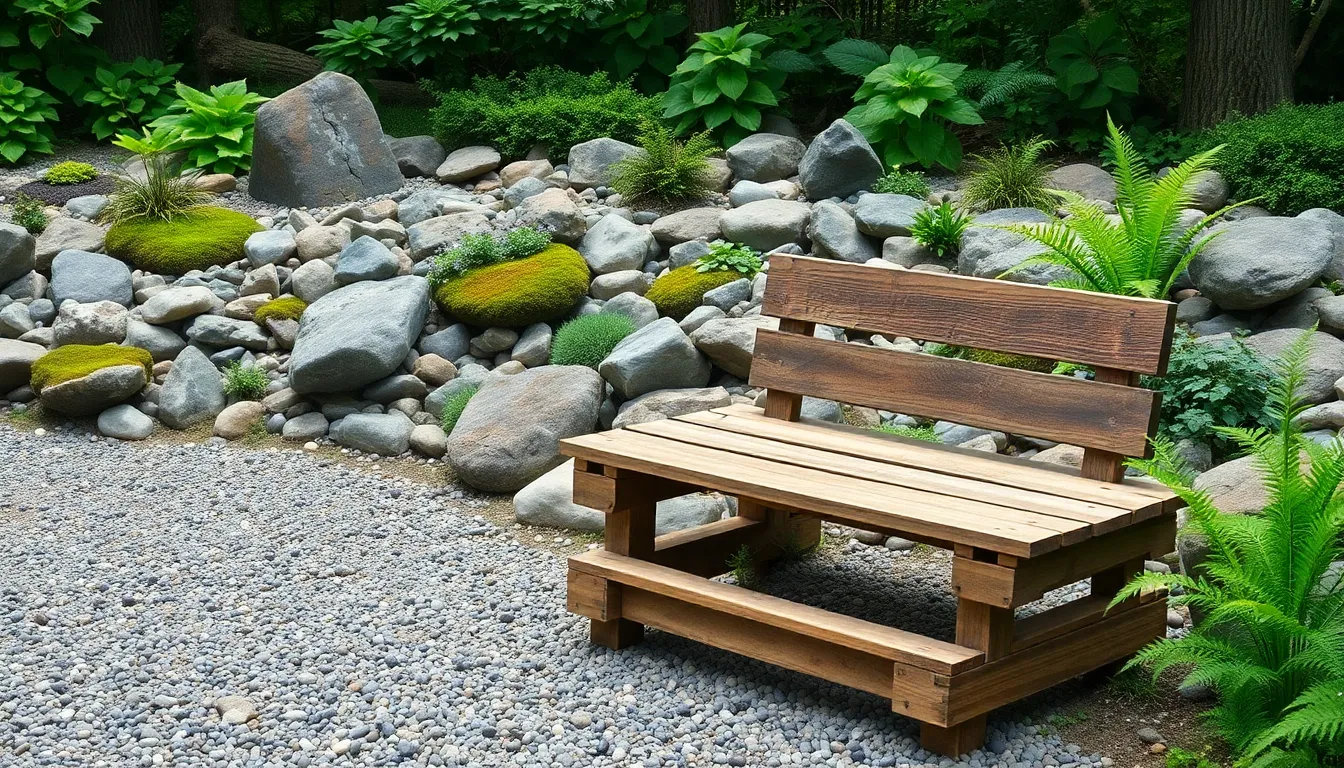
Creating your own Japanese garden doesn’t require a massive investment when you focus on resourcefulness and creativity. We’ve discovered that the most beautiful spaces often emerge from simple materials and thoughtful design choices.
Repurposed Materials and Creative Answers
Finding materials locally saves both money and transportation costs while supporting sustainable gardening practices. We recommend visiting local quarries where stones often cost significantly less than retail garden centers. Old bricks work exceptionally well for edging flower beds and creating winding pathways that mimic traditional Japanese design principles.
Wooden pallets transform into sturdy garden benches with minimal modification and basic tools. Sand the surfaces smooth and apply weather resistant stain to create seating that blends naturally with your garden environment. These benches provide meditation spots without the expense of purchasing commercial outdoor furniture.
Native plants reduce ongoing maintenance costs while ensuring your garden thrives in local conditions. Moss, ferns, and succulents require minimal watering once established and create the lush green foundation essential to Japanese aesthetics. Local nurseries often offer these plants at lower prices than exotic alternatives that may struggle in your climate.
Creative DIY projects using bamboo and driftwood add authentic touches without professional installation fees. Bamboo works perfectly for constructing privacy screens or traditional water spouts called shishi-odoshi. Driftwood pieces become natural sculptures that serve as focal points throughout your garden space.
Simple Rock Garden Installations
Gravel arrangements create instant tranquility using materials readily available at most industry supply centers. We suggest starting with a small 4×6 foot area where decomposed granite or fine pea gravel costs approximately $30-50 for complete coverage. Rake patterns daily to maintain the meditative quality these spaces provide.
River rocks serve multiple decorative functions from drainage answers to sculptural elements. Larger stones become natural seating areas while smaller ones edge planting beds and define garden boundaries. Strategic placement of three to five rocks creates balanced compositions that represent mountains or islands in traditional Japanese symbolism.
Minimal maintenance requirements make rock gardens perfect for busy homeowners seeking peaceful outdoor spaces. These installations need occasional weeding and rake maintenance but otherwise remain beautiful year round. Adding one or two specimen plants among the rocks provides seasonal interest without overwhelming the minimalist aesthetic.
Small spaces accommodate rock garden features through container installations and vertical arrangements. Even apartment balconies can house shallow trays filled with sand and carefully placed stones. These portable gardens offer meditation benefits while requiring minimal square footage and investment.
Homemade Decorative Elements
Crafting your own lanterns using recycled materials creates authentic lighting without expensive imports. We’ve found that large tin cans, mason jars, and even plastic containers work well when painted with appropriate colors and fitted with battery operated LED lights. These homemade versions provide the same ambient glow as traditional stone lanterns.
Bamboo water features cost significantly less than commercial fountains while offering the same soothing sounds. A simple shishi-odoshi requires bamboo poles, a pivot point, and basic plumbing supplies totaling under $75. The rhythmic tipping motion creates the peaceful atmosphere central to Japanese garden design.
Recycled materials become garden art through creative repurposing and imagination. Old ceramic pots transform into water basins called tsukubai when combined with small submersible pumps. Wine bottles buried neck down create interesting border elements that catch morning light beautifully.
Handmade elements reflect personal creativity while maintaining authentic Japanese principles of simplicity and natural beauty. Each project allows customization to fit your exact space requirements and design preferences. These personal touches often become the most cherished features of your completed garden sanctuary.
Seasonal Maintenance Tips for Year-Round Beauty
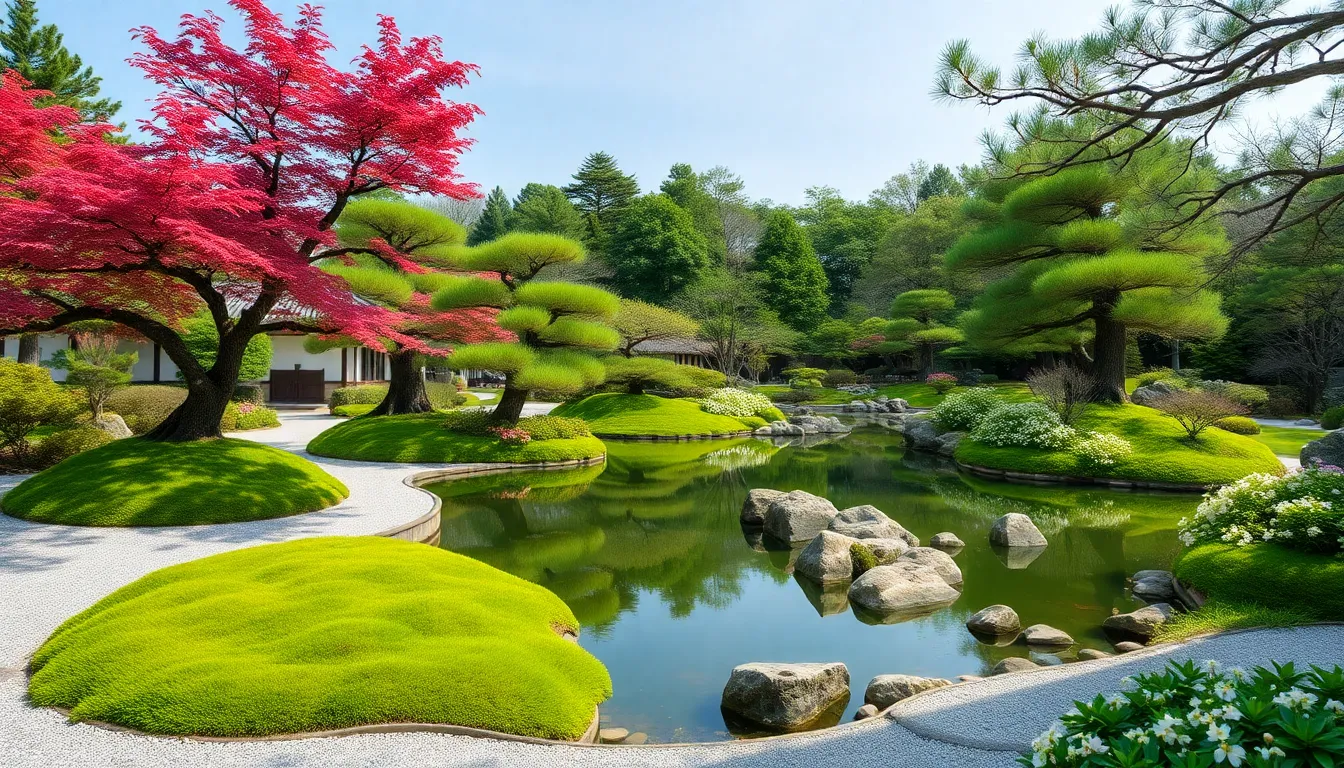
Maintaining your Japanese garden’s serene beauty requires thoughtful seasonal care that honors the natural rhythms of growth and dormancy. We’ll guide you through essential maintenance practices that keep your garden flourishing throughout the year.
Spring Pruning and Plant Care
Early spring emerges as the optimal time for pruning before new growth begins. We recommend timing your pruning activities just as winter frost subsides but before buds break open on trees and shrubs.
Trimming overgrown branches on signature trees maintains their sculpted natural forms. Focus on pine, maple, and camellia trees by carefully removing excess growth that disrupts their elegant silhouettes. Remove dead or damaged foliage and branches to encourage healthy new growth throughout the growing season.
Moss inspection becomes crucial during spring awakening. Gently rake moss areas to remove winter debris and mist regularly to promote vigorous growth while preventing drying. Check for bare patches that may need reseeding or transplanting from healthier sections.
Water feature cleaning restores clarity and function after winter dormancy. Clean ponds and water basins thoroughly by removing accumulated debris and algae buildup. Test water quality and replace if necessary to ensure optimal conditions for any aquatic plants or fish.
Mulch replenishment supports soil health and moisture retention. Apply fresh organic mulch around trees and planted areas to suppress weeds and maintain consistent soil temperature as growing season begins.
Winter Protection Strategies
Protecting moss from frost heave and drying winds preserves groundcover integrity. Cover delicate moss areas with burlap or evergreen boughs during harsh weather periods. Keep moss moist but avoid waterlogged conditions that can lead to rot and fungal issues.
Vulnerable plants require strategic shielding from winter desiccation. Japanese maples especially benefit from burlap screens or windbreaks that block harsh winter winds without completely blocking sunlight. Position protective barriers on the windward side of sensitive plantings.
Salt avoidance near plants prevents devastating root damage. Keep deicing salt and road salt runoff away from garden areas by creating barriers or drainage channels. Choose pet safe ice melts for pathways that won’t harm surrounding vegetation.
Rock and gravel area maintenance prevents aesthetic disruption. Clear leaves and organic debris from dry gardens and pathways regularly to prevent decomposition that can stain stones and alter intended visual effects. Rake gravel smooth to maintain clean geometric patterns.
Fall Cleanup and Preparation
Regular leaf removal prevents decay and maintains garden health. Clear fallen leaves from lawns, moss patches, and pond surfaces weekly during peak fall season. Accumulated leaves can smother moss growth and create algae problems in water features.
Light pruning removes problematic growth without winter vulnerability. Focus on dead or diseased wood removal while avoiding heavy pruning that creates fresh cuts unable to heal before freezing temperatures arrive. Save major shaping work for early spring timing.
Garden feature maintenance prepares hardscape elements for winter. Rake gravel paths and meditation areas smooth while removing any displaced stones or debris. Top up gravel or mulch levels as needed to maintain proper coverage and drainage.
Equipment maintenance ensures spring readiness and longevity. Clean all gardening tools thoroughly and apply light oil coating to metal surfaces before storage. Sharp, well maintained tools make spring pruning tasks more efficient and less stressful for plants.
Sustainable water collection maximizes natural resources. Use collected rainwater from barrels for moss misting and general garden watering since tap water often contains chemicals that can harm delicate moss ecosystems. Position collection systems before winter freezing begins.
Conclusion
Creating your own Japanese garden doesn’t have to be overwhelming or expensive. We’ve shown you how simple elements like strategically placed stones zen-style gravel patterns and carefully chosen plants can transform any outdoor space into a peaceful retreat.
Whether you’re working with a sprawling backyard or a tiny balcony these timeless design principles adapt beautifully to your unique situation. The key lies in embracing simplicity balance and mindful placement of each element.
Remember that Japanese gardens evolve slowly and reward patience. Start small with one or two features that speak to you then gradually build your tranquil sanctuary over time. Your future self will thank you for this investment in daily peace and natural beauty.
Frequently Asked Questions
What makes Japanese gardens so calming and peaceful?
Japanese gardens create tranquility through carefully balanced elements like flowing water, strategically placed stones, and minimalist plant selections. The design emphasizes harmony with nature, encouraging mindfulness through purposeful pathways and meditative spaces. The combination of natural materials, gentle sounds from water features, and clean lines helps reduce stress and promotes inner peace.
Do I need a large budget to create a Japanese-inspired garden?
No, Japanese gardens can be created on any budget using resourceful approaches. You can use repurposed materials like local stones and old bricks, choose native plants for lower maintenance costs, and create DIY features like homemade lanterns and bamboo water spouts. Container gardening is also an affordable option for small spaces.
Can I create a Japanese garden in a small urban space?
Absolutely! Japanese garden principles work well in small spaces through container gardening, balcony adaptations, and vertical gardening techniques. Use dwarf trees, moss, and ferns in portable containers, incorporate compact water features, and utilize walls for living greenery to maximize your available space while maintaining authentic aesthetics.
What are the essential elements of a zen garden design?
Zen gardens focus on simplicity and meditation through raked gravel patterns, carefully arranged stones symbolizing natural elements, and minimal plant selections. Key components include flowing patterns in decomposed granite or fine gravel, strategically placed stones representing mountains or islands, and evergreen shrubs or single specimen trees for tranquil ambiance.
How do I maintain a Japanese garden throughout the seasons?
Seasonal maintenance includes spring pruning, moss care, and water feature cleaning. Fall requires regular leaf removal and equipment preparation. Winter protection involves covering vulnerable plants and moss. Year-round practices include sustainable approaches like rainwater collection and maintaining the minimalist appearance through regular upkeep of pathways and plant health.
What types of water features work best in Japanese gardens?
Essential water features include koi ponds as vibrant focal points, bamboo fountains (shishi-odoshi) for rhythmic sounds, and gentle streams for garden connectivity. For smaller spaces, stone basins called tsukubai offer compact water elements. Each feature enhances tranquility while requiring proper maintenance for optimal function and aesthetic appeal.
Which plants are best for Japanese garden design?
Ideal plants include Japanese maples (like Bloodgood and Sango-kaku varieties) for seasonal color, moss for low-maintenance ground cover, ornamental grasses for texture and movement, and evergreen shrubs for year-round structure. Choose plants that embody natural aesthetics, balance, and symbolism while requiring minimal upkeep once established.
How should I design pathways in a Japanese garden?
Japanese garden pathways should encourage mindfulness through purposeful design. Use natural flat-topped stones arranged to mimic landscapes, incorporate moss for texture, and consider wooden bridges as transition symbols. Gravel and sand walkways with raked patterns can evoke water and promote calmness while maintaining design balance throughout the space.


